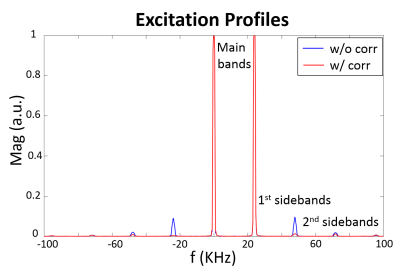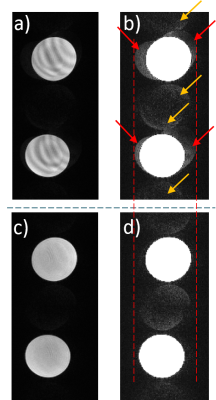1594
A method for suppressing simultaneous multi-slice (SMS) imaging artifacts caused by RF distortionsYuan Zheng1, Yu Ding1, Qing Wei2, Rongxing Zhang2, and Weiguo Zhang1
1UIH America, Houston, TX, United States, 2United Imaging Healthcare, Shanghai, China
Synopsis
In simultaneous multi-slice (SMS) imaging, the multi-band RF pulses have complicated waveforms and may suffer from distortions, which can cause sideband excitations and result in image artifacts. We have proposed a simple method for correcting the RF distortions using a prescan of the RF output, which can be conveniently integrated in general SMS applications to suppress such artifacts with a negligible increase of scan time.
Introduction
Simultaneous Multi-Slice (SMS) imaging is a technique that improves the time efficiency of MRI pulse sequences by exciting and imaging multiple slices at the same time1. It is closely related to in-plane parallel imaging in that both techniques need multi-channel coil arrays for data collection, and aliased images are separated using coil sensitivity variations. However, unlike in-plane parallel imaging which is achieved by adjusting the k-space sampling pattern, SMS imaging requires accurately broadcasting of complex multi-band (MB) RF waveforms for excitation. Distortions caused by the transmit chain could lead to additional excitation bands, which will show up as image artifacts. In this abstract, we present a method for eliminating the undesired sideband excitations by correcting MB RF waveforms using a prescan. Direct measurement of the RF output showed significantly suppressed sidebands; The SMS image artifacts were also effectively removed.Methods
We propose the following method for suppressing the excitation sidebands (Fig.1). After the initial MB RF waveform is prepared according to user inputs, it is broadcasted and the RF output is sampled, which typically takes only a few milliseconds. The frequency profile is subsequently analyzed. Since the intended excitation bands are known, it is straightforward to extract the sidebands using a mask. The compensation time-domain RF waveform is calculated by inverse Fourier transform of the inverted sidebands. Finally, the corrected MB RF waveform is generated by adding the compensation waveform to the initial MB RF waveform, which can then be used for SMS imaging. The amount of RF distortion strongly depends on the hardware. Here we chose an RF transmit chain with relatively large distortions in order to effectively show this problem and demonstrate the proposed correction technique. An MB RF pulse was generated by combining 2 identical 90 degree SLR pulses2 24 KHz apart. The time-bandwidth product of the SLR pulse was 6 and the duration was 4 ms. The RF output before and after correction were directly sampled by an integrated loop and compared to the input waveform. We also performed SMS imaging and compared the artifact level with and without RF correction. Images of a water cylinder phantom were acquired on a 1.5T uMR 560 scanner (United Imaging Healthcare, Shanghai, China) with a 16 channel head coil. The same RF transmit chain as used for Fig.2 and 3 was installed for this test. An SMS gradient-echo EPI sequence was used for data collection. Images were acquired with: slice thickness = 3.5 mm, FOV = 230 x 230 mm, resolution = 112 x 112, FA = 90 deg, TE = 61 ms, number of slices = 34, BW = 1910 Hz/pixel, MB factor = 2. For the purpose of this experiment, controlled aliasing was not applied. Single-band calibration images were acquired separately, and the slice-GRAPPA algorithm3 was used for image reconstruction.Results
Fig.2 shows the time domain waveform comparison between the RF input and output without correction. Distortions can be easily identified. Fig.3 compares the frequency spectra of RF output before and after correction. The 1st sidebands were about 8% the size of the main bands before correction, and were suppressed to under 1% using the corrected RF waveform. Fig.4 shows selected slices of the SMS images. The image artifacts caused by undesired sideband excitations were largely removed using the proposed RF correction technique.Discussion
MB pulses have complex waveforms (Fig.2) that demand high fidelity of the RF transmit chain. Hardware that perform well on typical single-band pulses may show some degrees of distortion that may lead to image artifacts. We have demonstrated the proposed RF correction method with an MB = 2 waveform. However, it should be straightforward to extend this technique to correct more complex RF pulses, such as the ones with higher MB factors, as long as the undesired excitation bands can be separated from the intended excitation bands. It is also worth noting that the prescan only directly samples the RF output instead of MR signals, taking just a few milliseconds. Finally, we would like to point out that this technique can be used iteratively, i.e., the remaining undesired excitations in Fig.3 after correction can be further suppressed by adding a compensation pulse that cancels the residual sidebands.Conclusion
The distortion of MB RF pulses in SMS imaging can lead to sideband excitations, which may result in image artifacts. We have proposed a simple and reliable method for correcting the MB RF distortions using a fast prescan, which can be conveniently integrated in general SMS applications to suppress such artifacts with a negligible increase of scan time.Acknowledgements
No acknowledgement found.References
- Barth M et. al., Simultaneous multislice (SMS) imaging techniques, Magn Reson Med. 2016 Jan;75(1):63-81.
- Pauly J, et. al., Parameter relations for the Shinnar-Le Roux selective excitation pulse design algorithm, IEEE Trans Med Imaging. 1991;10(1):53-65.
- Setsompop K, Blipped-controlled aliasing in parallel imaging for simultaneous multislice echo planar imaging with reduced g-factor penalty. Magn Reson Med. 2012 May;67(5):1210-24.
Figures

Workflow of the proposed
RF correction method for MB pulses.

Comparison between the
input and output of an MB = 2 waveform, with normalized peak magnitudes. The
output waveform was obviously distorted.

Frequency spectra of the
RF output with and without correction. The 1st sidebands were ~8% of
the main bands before correction. The sidebands were significantly suppressed (<1%)
using the RF correction procedure described in Fig.1.

Comparison of
SMS image artifacts of a water cylinder phantom with and without the proposed
RF correction technique. Two simultaneously excited slices imaged without RF
correction were show in a). The brightness window was adjusted to better show
the artifacts from sideband excitations in b). Artifacts caused by RF sideband
excitations were indicated by red arrows, while those caused by common EPI N/2
ghosts were indicated by orange arrows (irrelevant to excitation problems). With
the proposed RF correction technique, RF-related artifacts were effectively
removed, as shown in c) and d).